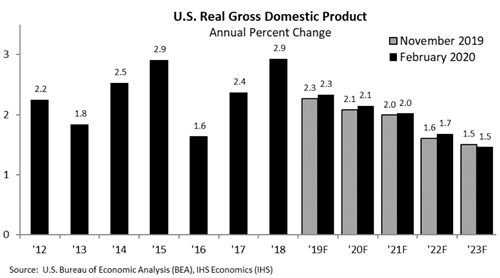Minnesota's positive budget balance coupled with continued modest economic growth give us short-term good news, according to today's release of the February Budget and Economic Forecast by Minnesota Management and Budget. But the budget outlook also gives reasons for caution, with only a small structural balance in the next budget cycle before accounting for inflation and slowing economic growth in the future.
- Today’s February forecast showed the state is projecting a $1.5 billion positive balance for the remainder of the FY 2020-21 two-year budget cycle. That's an improvement of $181 million over the November forecast.
- The forecast predicts a $465 million structural balance for FY 2022-23. That means that the state is expected to bring in $465 million more in revenues than it will spend in the next biennium; this measure doesn't include any money carried forward from the prior biennium. However, that number also doesn’t include what it would take for most current public services to keep up with inflation. When the impact of inflation is accounted for, the balance in FY 2022-23 turns into a deficit of $654 million.
- The economy is expected to continue growing over the next several years at rates very similar to those projected in the November forecast. However, that growth is slow, which makes the economy less resilient and increases the likelihood that any economic challenges could tip us into a recession.

- The forecasters are fairly confident in their projections. They give a 65 percent chance to their baseline economic scenario. They also give a 25 percent chance to a pessimistic scenario in which the U.S. experiences a short recession starting in 2021, and a 10 percent chance to a more optimistic scenario. As always, the forecasters name the risks to their projections, which were put together in early February. The forecasters noted that as of February 21, the impact of the coronavirus is expected to be "modest in the context of the large U.S. economy," but also that new information is developing daily.
Similar to what we saw in the November forecast, the state has short-term good news that cools off in the next budget cycle, and important unknowns about the future. This underscores the opportunity this session for one-time investments toward building prosperity throughout the state, such as in child care and health care. But any action taken this year is essentially a downpayment. To make sustainable investments for the longer term, we'll need to raise more revenues to invest in great schools, safe and thriving communities, and other building blocks of broader prosperity.
Today's forecast also illustrates the need for accurate information in the forecast. While the forecast shows a $465 million structural balance in FY 2022-23, that does not take into account the $1.1 billion it would take to keep up with inflationary pressures. Due to a law passed in 2002, the state's economic forecast adjusts state revenues for inflation in the next biennium, but does not do the same for many areas of spending. This week, the House Ways and Means Committee heard
House File 150 (Schultz) that would reintroduce including a measure of overall inflation on spending in calculating the state's budget balance. This is a change that would give policymakers, advocates, and the public a clearer understanding of the full impact of budget choices made today.
Now that the February forecast is out, Governor Tim Walz will release his supplemental budget proposal sometime next month, and legislators have the numbers they need to start putting their budget proposals together. Stay tuned to our blog to keep up with the latest.